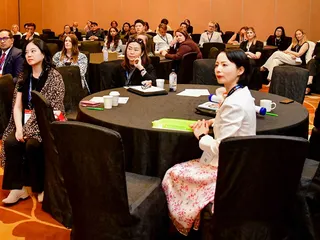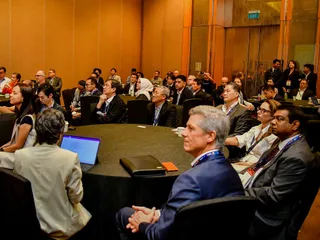Stop Human Trafficking: Aviation's Vital Role
Contact Our Team
For more information about how Halldale can add value to your marketing and promotional campaigns or to discuss event exhibitor and sponsorship opportunities, contact our team to find out more
The Americas -
holly.foster@halldale.com
Rest of World -
jeremy@halldale.com

Key Takeaways
- Nearly 80% of international human trafficking journeys pass through official border control points, including airports
- Cabin crew see hundreds of passengers daily and are uniquely positioned to identify trafficking victims
- Simple awareness training can transform airline staff into frontline defenders against human trafficking
- The "do no harm" principle is essential when responding to suspected cases
- Proper reporting procedures can save lives without putting crew or passengers at risk
At the Asia Pacific Aviation Training Summit (APATS) 2025 in Singapore, Dr. Mizuki Urano, Aviation Safety Advocate, delivered a compelling presentation on developing training programs to combat human trafficking through aviation industry awareness. Her research demonstrates how cabin crew can serve as critical allies in identifying and responding to this global crime.
Interested in more key issues for cabin crew? Join us at EATS this November to explore more topics.
The Hidden Crisis in Aviation
Dr. Urano began her presentation with a powerful awareness test using the famous "moonwalking bear" video, where viewers counting basketball passes often miss an obvious bear walking across the screen. "The message is that it's easy to miss something you're not looking for," she explained. "Now imagine that the moonwalking bear was a human trafficker or a victim of human trafficking."
This analogy perfectly captures the challenge facing aviation professionals. The statistics are sobering: data from International Organization for Migration (IOM) cases over the past decade show that nearly 80% of international human trafficking journeys crossed through official border control points, including airports.
"Unfortunately, the global air transport system can be misused by criminals for the illegal trafficking of men, women and children," Dr. Urano noted, emphasizing why the aviation industry must take an active role in combating this crime.
Global Framework and Industry Collaboration
Dr. Urano's research is grounded in the United Nations' Sustainable Development Goals, particularly Goals 5 (gender equality), 8 (decent work and economic growth), and 16 (peace, justice, and strong institutions). During her graduate studies, she examined the concept of human security, which forms the basis of the SDGs, incorporating these principles into training programs she developed at Japan Airlines.
The International Civil Aviation Organization (ICAO) has developed comprehensive guidance materials in collaboration with stakeholders. Dr. Urano highlighted three key circulars:
- Circular 352: Framework for training packages focused on identification and response
- Circular 357: Guidelines for managing crew reports of suspected cases
- Circular 362: Preventing trafficking in aviation supply chains
"This newest circular highlights the importance of raising the awareness of different groups of people in the aviation industry, such as ticket counter agents, gate agents, CAA inspectors, catering services, fuel providers, and even passengers," she explained.
Modern Trafficking Realities
Traditional perceptions of human trafficking are evolving. Dr. Urano shared a recent case from January 2025 involving a 17-year-old Japanese high school student who was lured to Thailand through an online gaming contact, promised well-paid work abroad, then forced into scam operations in Myanmar.
"Human trafficking has traditionally been associated with people in dire economic situations who are forcibly kidnapped, smuggled, or moved across borders and exploited. However, in this case, syndicates are increasingly targeting middle to upper-class individuals," she noted, describing how authorities at Narita International Airport now display warnings stating: "Profitable work abroad is dangerous. You may be locked up, tortured and killed."
Cabin Crew as Frontline Defenders
The presentation emphasized cabin crew's unique positioning to identify trafficking. Mikaela from Sky regional airlines, featured in an ICAO interview, explained: "Cabin crews see hundreds of people daily. They are trained to react to and manage a lot of situations that affect people as they travel from place to place. Cabin crew are our best assets when it comes to ensuring the safety, security, and well-being of our passengers on board."
Dr. Urano shared two powerful real-world examples. Flight attendant Shelia Federick from Alaska Airlines noticed something wrong with a well-dressed older man traveling with a disheveled teenage girl. When Frederick tried to speak to the pair, the girl remained silent and the man became defensive. Federick then discreetly left a note for the girl in the restroom, instructing her to go there. The girl wrote back that she needed help, confirming it was a trafficking case. Frederick immediately informed the pilot, and police were waiting at the terminal upon arrival. Federick's message: "If you see something, say something."
From the victim's perspective, Fatima from Ghana shared her experience being trafficked to Europe. Her trafficker controlled her communication and seating arrangements during the flight. Her plea to cabin crew: "If you see a passenger who isn't allowed to talk on the plane, please raise the alarm before the flight arrives. By helping one victim, you help 1,000."
Training Implementation and Recognition Indicators
Dr. Urano's research identifies comprehensive indicators cabin crew should recognize:
Behavioral indicators include:
- Avoiding eye contact and social interaction
- Avoiding authority figures
- Being unusually submissive to travel companions
- Refraining from speakimg independently
- Providing inconsistent responses to questions
Situational indicators include:
- Not having control of their travel documents
- Language barriers with companions
- Inappropriate clothing for travel route
- No personal belongings or carry-on baggage
- Being unaware of final destination
- Not knowing who will meet them upon arrival
The "Do No Harm" Principle
Central to Dr. Urano's training approach is the "do no harm" concept, ensuring potential victims aren't further jeopardized while protecting crew and passenger safety. Key principles include:
- Being discreet with discussions and information
- Not confronting the trafficker
- Not attempting to rescue the victim
- Act normally without displaying unusual concern
- Ask indirect questions as part of natural conversation
"When you notice something unusual, you have to follow the reporting procedures of your company," Dr. Urano emphasized. "It is important to ensure that a potential victim is not further jeopardized, and safeguard cabin crew and passengers and your personal safety."
Comprehensive Training Programs
Dr. Urano's research shows effective training should cover multiple competencies beyond recognition, including situational awareness, communication, leadership, teamwork, passenger management, and problem-solving. She advocates for joint training with flight crew and ground staff, moving beyond online-only formats to include peer discussions and scenario exercises.
"I know many airlines may conduct this kind of training online, but it is important to discuss this issue with your peers and give them the opportunity to consider how they would respond as a team to suspected cases of human trafficking," she stated.
Moving Forward
Dr. Urano's presentation concluded with a call to action for the aviation industry. Her research demonstrates that with proper training, awareness, and procedures, cabin crew can become powerful allies in the fight against human trafficking while maintaining the safety and security standards essential to commercial aviation.
The ultimate responsibility for dealing with suspected cases remains with law enforcement, but as Dr. Urano noted: "Even if it turns out not to be a crime after reporting, you will not be held responsible for making the report. Reporting itself is a meaningful action."
Through continued collaboration between airlines, international organizations, and training professionals, the aviation industry can transform from an unwitting facilitator of trafficking into a formidable barrier against this global crime.
Conversations on more pressing issues in cabin crew training will continue at the European Aviation Training Summit (EATS), where experts will share insights on selection, preparation, and practical skills. These presentations during Session 3 will examine approaches to identifying the right candidates, preparing new hires before airline training, and emphasizing hands-on skills in initial courses to strengthen workforce readiness.
Register for EATS 2025!.png/r%5Bwidth%5D=320/17954010-9233-11f0-a497-e3df816d9f32-Screenshot%202025-09-15%20at%2013.webp)

